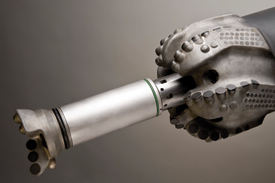Finding new ways to drill for unconventional reserves and lowering overall costs means ‘doing more with less’ by using more efficient technologies.

The Portal Bit is modified with a removable central section when running hardware is deployed in front of the logging string. When the latch is engaged the center section of the bit will deploy out the bit and remains in possession of the running hardware and logging tools.
Wouldn’t it be easier to evaluate well data from total depth (TD) without spending the time and expense of conditioning the borehole and tripping drill pipe from the hole in order to log? Yes, it would; a new technology is doing just that.
Known as through-the-bit logging, the system uses a specially designed bit that ensures a successful log regardless of borehole conditions, saving both time and money. This new conveyance method is being developed by ThruBit LLC. By using small-diameter logging tools the system can convey through the drill string and out the specially designed polycrystalline diamond compact bit, known as the Portal Bit, which is modified with a removable central section when running hardware is deployed in front of the logging string. When the latch is engaged, the center section of the bit will detach while retaining possession of the running hardware and logging tools.
By using the Portal Bit-enabled logging system, formation evaluation data is acquired with either wireline or memory tools, in the latter case while tripping drill pipe out of the well, thus improving rig efficiency. Deployment through the drillstring improves the reliability and lowers the cost of logging operations. The system can also be used to quickly confirm a coring or casing point or to evaluate a zone. The tools are specifically designed to secure quality petrophysical data in many different well conditions including multi-well development fields, tough hole logging conditions, and horizontal well bores.
Engineering challenges
Through-the-bit logging began its development in the late 1990s. After undergoing a series of engineering challenges, the technology is now ready for commercialization in 2009. One of the biggest hurdles was to increase the efficiency and reliability of the latch running system to meet typical standards of oil and gas operations. To date, more than 32,000 ft (9,760 m) of hole has been drilled with the Portal Bit design and 1,000 hours of circulation testing have proven the reliability of the latch, which has been triggered more than 270 times and continues to function.
Other challenges included changing design and improving methods of deployment such as horizontal pump-down. In recent months, ThruBit has readied the system for the market through a full battery of tests. The logging tools designed to work through the company’s portal bit are designed to withstand temperatures of more than 300°F (148°C) and bottomhole pressures of 15,000 psi. These features have been tested both in the lab and the field and may prove beneficial for unconventional shale plays like the Haynesville in East Texas and North Louisiana.
Moving forward with the basic drill-latch log system could drastically change the way logs are deployed and obtained in new well bores. New-style Portal Bits will be designed with specifically tailored cutting structures to work in conjunction with the company’s new logging tools. Through-the-bit logging could become part of a trend bringing smaller downhole equipment to the market.
Capturing value in the field
In December 2008, the first commercial application of through-the-bit logging was conducted in a Texas well. The system successfully completed a log while drilling the well to TD. The 12,500 ft (3,813 m) well bore included an s-bend with a bottomhole temperature of 307°F (153°C). The system obtained array induction, compensated neutron, compensated density, and gamma ray (triple combo) logs through the zones of interest back to 7,500 ft (2,288 m). The company’s Through Pipe and Bit conveyance method validated the Portal Bit’s value.